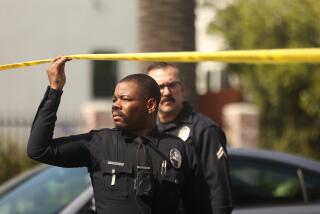Black Males’ Murder Risk 6 Times as High as Whites’
- Share via
WASHINGTON — There is one chance in 21 that a black American male will be murdered, odds about six times greater than those confronting white men, according to a survey of crime risks released Sunday by the Bureau of Justice Statistics.
The bureau, an agency of the Justice Department, included the data in its new Crime Risk Index, a statistical indicator developed from five years of estimates compiled for the bureau’s continuing National Crime Survey. A nationwide survey of about 125,000 persons, taken every six months, is used to chart the incidence of violent crime.
For the record:
12:00 a.m. May 8, 1985 For the Record
Los Angeles Times Wednesday May 8, 1985 Home Edition Part 1 Page 2 Column 1 National Desk 1 inches; 24 words Type of Material: Correction
In a story in Monday’s editions, The Times incorrectly identified the director of the Justice Department’s Bureau of Justice Statistics. He is Steven R. Schlesinger.
“The Crime Risk Index shows that males are more likely than females to be victimized by violent crime, blacks more likely than whites, the young more than the old, the poor more than the wealthy and the unmarried more than the married,” the bureau’s director, James R. Schlesinger, said in announcing the findings.
3% Risk of Violent Crime
Using figures for 1978 through 1982, the bureau found that overall risks that an American 12 years of age or older will become a victim of the violent crimes of rape, robbery or assault were about 3% a year through the five-year period.
Homicide data compiled by the National Center for Health Statistics of the U.S. Public Health Service indicates that “a person in this country has about one chance in 10,000 of being murdered in a single year, but the risk is 1 in 133 over an entire lifetime,” Schlesinger said.
The statistics showed also that the lifetime risk can vary with race and sex. Overall, the estimated chance of being murdered was put at 1 in 282 for all females and 1 in 84 for all males. The odds of a white male’s becoming a homicide victim were estimated at 1 in 131, much less than the 1 in 21 chance for blacks. For females, the risks were put at 1 in 369 for whites and 1 in 104 for blacks.
The study estimated that 3.2% of the population--about 6 million Americans over the age of 11--fell victim to violence in 1982. But the impact fell disproportionately on poor, young, unmarried males.
In its summary of all crimes covered, the survey estimated that 5.9% of white males and 7% of blacks in the 12-15 age group were victims in 1982. Among males 16 to 19, the victimization estimate was 8.5% for whites and 8.3% for blacks.
The estimated rates tapered off to 4.9% for whites and 6% for blacks between 25 and 34, then fell steadily thereafter for both races. In the over-65 age group, the estimated rates were 0.7% for white males and 1.5% for blacks. In all age brackets, assault was the crime most generally reported.
For females, the 1982 victimization rate reached its peak for both races in the 16-19 bracket, for which the estimates were 4.6% for whites and 5% for blacks. Once again, the principal crime in both categories was assault. Rape accounted for 0.4% of the crimes against white females in the 16-19 age group, and the estimate was less than 0.3% in all other age brackets.
The data showed a direct relationship between victimization and family income. Most at risk in 1982 were whites from households with incomes of less than $3,000, of whom 6.3% became violent crime victims, compared with 5.6% for blacks.
The study said that 2.3% of married males were victims in 1982, compared with 7.1% of men who had never married. The figure for married women was 1.2%; it was 3.9% for women who had never married.
More to Read
Sign up for Essential California
The most important California stories and recommendations in your inbox every morning.
You may occasionally receive promotional content from the Los Angeles Times.













